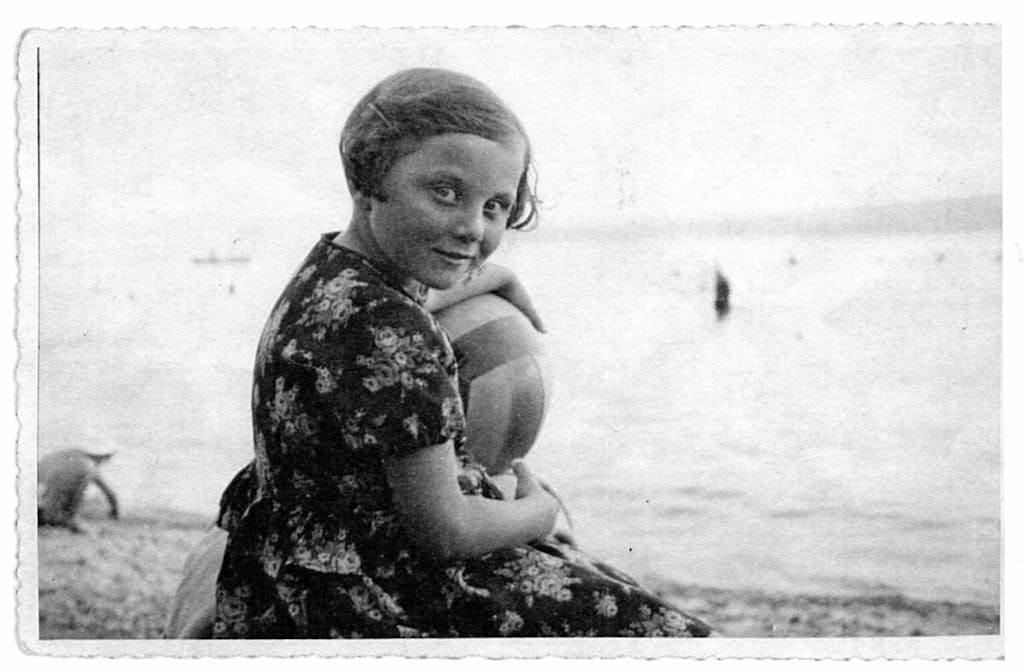Do you have a favourite piece of clothing? For Holocaust survivor, Trude Silman, one particular scarf has immense value to her – it was not even her scarf, but her mother’s scarf that she found in her suitcase when she arrived in England with her Aunt and cousin.

Trude’s Scarf
In 1939, when Trude was 10 years old, her mother announced that Trude was to join her Aunt and cousin to England as her Aunt had recently received permission to work in the UK. Trude was from a Jewish family in Bratislava, Czechoslovakia and life was becoming increasingly dangerous as the threat from Nazi Germany became apparent. As Trude prepared to leave her home for the last time, Trude’s mother gave her a packed suitcase.
Trude said goodbye to both of her parents at Bratislava train station before embarking on a four-day rail journey to England. Once in England, Trude unpacked her suitcase and discovered various items. This included her mother’s red scarf, her father and grandmother’s prayer books and a dressing gown cord (which can also be seen in the exhibit archive). Some may think that Trude’s mother packed the scarf as a way to protect her child from the cold or perhaps just “something easy to pack in a small case”. Instead, Trude believes the scarf held greater meaning, as her mother always wore this particular scarf and was likely packed as a memento. As a child, Trude especially liked the scarf because it was something physical that she could touch and remember her mother by. As Trude grew older, the scarf became even more special to Trude because it is her last connection to her mother. She never saw her again after leaving Bratislava.

A Fashion Statement
Where did scarves come from and how have they become so trendy? Scarves originate all the way back to Ancient Egypt, Queen Nefertiti wore a scarf on her head as protection from her magnificent jewelled headpieces. Scarfs were also worn by men in Ancient Rome as ‘sweat cloths’ to keep them cool and dry. Napoleon Bonaparte even brought a pashmina scarf from Egypt as a gift to his first wife, Josephine, which started her collection of over 400 scarves over the next three years (and acquiring a total value of £80,000).
Scarves became popular in 19th century Britain, as cashmere shawls were regularly worn by Queen Victoria and influenced women’s fashion. It wasn’t until World War One when scarves were regularly used to keep people warm. Women and children would knit socks, sweaters and scarves and send them to the trenches to keep the soldiers warm during harsh, wet and cold conditions. RAF Pilots also wore silk scarves as the soft fabric protected their necks from chafing. Light silk scarves in bright prints became extremely popular during the post war period and scarves continued to be popular among men, women and children.
At the outbreak of the Second World War in 1939, women in Britain were drafted to fulfil male professions and occupations, including in manufacturing and factory work. Safety concerns arose in factories and women had to make sure that their hair was swept back. Many women used headscarves to cover their hair, although they were often dull colours as rationing meant that the only fabrics available were cotton and linen, which were cheaper and more accessible.
After the Second World War, everyone wanted a brighter palette and so patterned scarves attracted a lot of people, as did silk scarfs. Silk scarves were popular due to Audrey Hepburn and Grace Kelly wearing them in movies and whilst at home in New York and Monaco. Brigitte Bardot hit headlines by wearing her scarves as a headband and again as an arm sling. Queen Elizabeth II was even featured in a postage stamp wearing a scarf. However, scarves as fashionable accessories declined in the 1990s. Scarves have since made a reappearance and have been used for diverse purposes, including twill weaves wrapped around the handbag handles to make them look more chic. Scarves today are also used as belts, hair ties, headbands, wrapped around hats and braided within the hair. Lastly, we are well aware that during the cold months we wear the scarfs around our necks to keep the cold out and to stay warm.

Memories
Trude’s mother gave Trude something that she could have worn throughout the different eras and even today, 80 years later. The red scarf is something that Trude has always treasured. During the Second World War, it kept her connected to her mother and gave her hope. Although Trude was never able to see her mother again and has never learned of her mother’s fate, the scarf has since become an object that holds immense symbolic value because it represents a lasting emotional connection to her mother. Trude can look at and remember all the fun times they had together. It is also a reminder of her final moment with her parents at the Bratislava train station and the last hugs and kisses they shared.

You can learn more about Trude’s story here.
Beth Purslow
History Student at The University of Huddersfield
03/03/21
